|
<<< Back to Safety and Health Information Bulletins - Table of Contents by Year |
 Printing Instructions
Printing Instructions |
| |
|
 |
U. S. Department of Labor
Occupational Safety and Health Administration
Directorate of Science, Technology and Medicine
Office of Science and Technology Assessment |
Hazards of Transporting, Unloading, Storing and Handling Granite,
Marble and
Stone Slabs
|
|
Safety and Health Information Bulletin |
|
|
SHIB 08-12-2008 |
|
|
This Safety and Health Information Bulletin is not a standard or regulation, and it creates no new legal obligations. The Bulletin is advisory in nature,
informational in content, and is intended to assist employers in providing a safe and healthful workplace.
The Occupational Safety and Health Act requires
employers to comply with safety and health standards promulgated by OSHA or by a state with an OSHA-approved state plan. In addition,
pursuant to Section 5(a)(1), the General Duty Clause of the Act, employers must provide their employees with a workplace free from recognized hazards likely to
cause death or serious physical harm. Employers can be cited for violating the General Duty Clause if there is a recognized hazard and they do not take
reasonable steps to prevent or abate the hazard. However, failure to implement any recommendations in this SHIB is not, in
itself, a violation of the General Duty Clause. Citations can only be based on standards, regulations, and the General Duty Clause. |
Preface
Unloading stone slabs from containers, storing them in "slab-racking" systems, moving and handling stone slabs with equipment, and loading stone slabs onto trucks can be dangerous.
This Safety and Health Information Bulletin (SHIB) discusses ways to minimize caught-by, crushed-by, and struck-by hazards associated with these work tasks. Awareness of the appropriate precautions highlighted
in this SHIB can help prevent serious injuries and fatalities related to these activities.
Purpose
The purpose of this SHIB is to:
- Alert employers and employees to the hazards associated with slab handling, transport and storing, loading and unloading operations,
- Provide information and recommendations to lessen the potential for employee injuries when performing these operations,
- Remind employers to establish stone slab handling procedures in their workplaces,
- Stress the importance of training employees on safe workplace procedures, and
- Ensure that employees follow safe stone slab handling procedures.
Background
Serious injuries and fatalities occur during the handling, loading, and unloading of large heavy stone slabs. Stone slabs can vary in weight from several hundred to several thousand pounds.
OSHA addressed this concern in 2005 by issuing a SHIB detailing the hazards associated with transporting and unloading stone slabs from delivery trucks. That SHIB did not address, however, the hazards associated
with the unloading of stone slabs from containers or other unique in-house handling hazards that could result in serious injuries and fatalities.
OSHA’s Integrated Management Information System (IMIS) data from 1984-2006 confirms that 46 fatalities nationwide were associated with the handling and storage of stone slabs. Unsafe handling and transportation
of stone slabs have resulted in many other serious injuries as well. OSHA’s Region VIII Englewood, Colorado Area Office reported that 11 of the 46 fatalities associated with handling and storing stone slabs occurred
in their region during stone yard activities. Additionally, Region I reported three fatalities within an eighteen-month period associated with the storage of stone slabs in
"slab racking" systems. These fatalities
took place in Massachusetts, Rhode Island and Connecticut. In each case, the employee was crushed between several slabs weighing from 4,000 to 6,000 pounds. OSHA’s Chicago North Area Office also investigated two
fatal accidents and two serious injuries involving unloading slabs from containers.
A summary review of the accident investigations revealed that employees were killed or sustained crushing injuries from slabs shifting inside a container or when unloading slabs using industrial forklift trucks equipped with boom attachments.
Unloading, storing, handling, moving, and loading stone slabs present a variety of hazards that require specific safety procedures. The following is a summary of the hazards that have been documented.
Unloading Stone Slabs from Containers
Wood supports are provided by some suppliers to prevent bundles of slabs from shifting inside containers during shipping. Without the wooden supports, the slabs can shift, slide, and/or collapse. Employees have
removed these supports when unloading and have become trapped or crushed from unanticipated shifts or collapsing slabs.
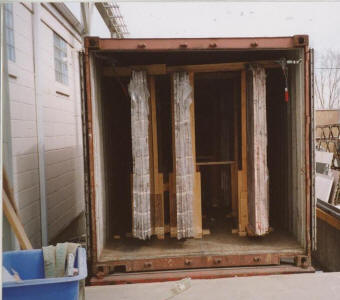
Stone slab container with wood supports in place
from supplier.
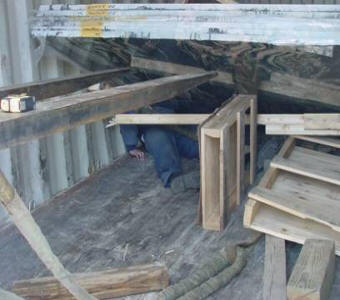
Employee was crushed after removing wood supports.
Storage of Stone Slabs
When the slabs are off-loaded, they are often placed in a rack structure for storage. These racks may be constructed of metal and/or wood. One type of racking system uses an A-frame structure.
The slabs are placed against the back of the A-frame or against another slab.
In some cases, the A-frames were not designed properly to support the weight of the slabs or to prevent the remaining slabs from shifting when one slab is removed. In other instances, the slabs were not secured
with restraining devices and/or tie-downs to keep them from sliding, nor were the A-frames inspected to ensure structural integrity.
In order to position stone slabs near vertical (90 degrees), employees sometimes stand in front or behind the slabs (within what is known as the
"fall shadow"). Standing in the fall shadow can result in a crushing
injury or fatality should the slab tilt too far.
The "slab rack" is another storage system that is used throughout the stone slab handling industry. Several companies manufacture and distribute these types of storage systems and all are of a similar design.
These "slab racks" consist of two horizontal bases and poles. The bases have holes fabricated in the top and bottom for insertion of the poles. After the poles are installed in the base, the stone slabs are
placed between the poles. Placement and removal of slabs are performed by material handling equipment.
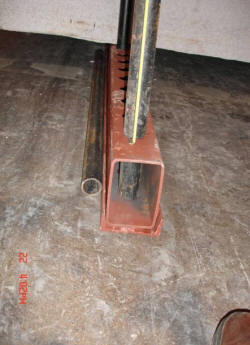
"Slab rack" base with pole fully inserted.
Failure of this racking system is common. Overloading the rack from the weight of the slab can deform the base causing the pole to come out of the bottom hole. When this occurs, the pole is held in place only
by the upper part of the base, creating instability, which can result in the failure of the slab rack.
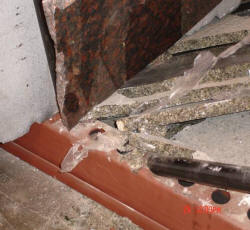
Failure of the "slab racking" system. The
bottom of the pole was not inserted into the
base.
The presence of objects or other debris in the base holes can also prevent the full insertion of the pole into the base, causing instability.
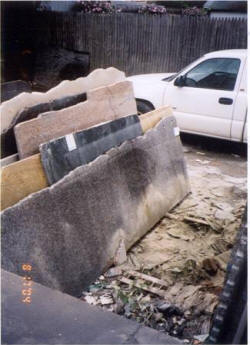
Debris preventing the complete insertion
of the poles into a "slab rack."
Handling and Moving Stone Slabs
Mechanical equipment, such as cranes and powered industrial trucks, are often used to transport stone slabs within a facility. Hooks, chains, clamps, straps and other
lifting devices are also used as rigging. Often an employee acts as a spotter to assist in the transfer of the stone slabs.
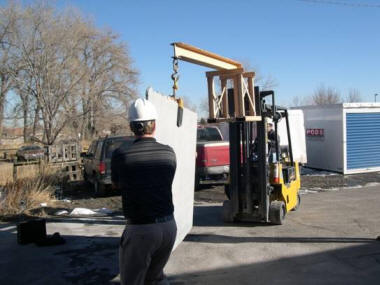
Illustrates employees staying out of the slab’s fall shadow
during
slab transport.
Prior to moving stone slabs from the racks to the work area, employees may be exposed to a crushing hazard when attaching a clamping or lifting device. Typically, a wedge is used to create a space
between the slabs prior to attaching the clamping/lifting device. In numerous instances, however, employees have either placed themselves between the slabs or they have improperly positioned the
wedge between slabs. Both of these instances resulted in employees being crushed when slabs shifted and leaned.
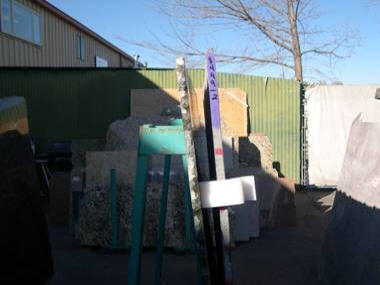
Illustrates the use of a wedge from the end of the slab. If
slab failure
should occur, the employee will not be in the
fall shadow.
Loading Stone Slabs onto Flatbed Trucks
Stone slabs are loaded onto a flatbed truck with mechanical equipment such as a powered industrial truck with a boom or an overhead crane.
The flatbed trucks may have A-Frame supports, or pole racking systems to secure the slabs for transport. Employees who are engaged in loading stone slabs are exposed
to caught-by, struck-by, and/or crushed-by hazards.
|

General Recommendations
Employers who are engaged in the handling and storage of slabs must prevent caught-by, struck-by, and/or crushed-by hazards in their workplace. The following are general recommendations:- Pre-plan work to identify the hazards, safe work practices, and the equipment that will be used to perform the work safely.
- Develop and implement safe stone slab handling procedures for transporting, loading and unloading slabs from containers and storage areas.
- Provide mechanical handling equipment appropriate to the task.
- Inspect material handling equipment before use to assure that it is in good condition. Defective equipment must be immediately reported and repaired or replaced before use.
- Instruct and train employees on the proper material handling procedures.
- Ensure that employees follow safe stone slab handing procedures.
Recommendations for Storage of Stone Slabs
The following recommendations will minimize the potential hazards associated with
"stone racks" and other storage racks for storing stone slabs:
- Design storage racks to withstand the loads and forces imposed on them.
- Design a storage rack system to secure slabs from shifting, sliding and collapsing, or provide secondary bracing or a restraint system to secure slabs from shifting, sliding and collapsing.
- Ensure that the "slab racks" are properly installed. Inspect each component to ensure that poles can be inserted into the holes.
- Maintain the rack, ensuring that no debris or other objects interfere with
the insertion of the poles used with "slab racks."
- Develop and implement procedures for the placement and removal of slabs from the racks, keeping employees out of danger zones.
- Do not allow employees to use damaged storage racks.
- Inspect the storage racks prior to loading. Ensure that the racks are properly installed. Look for:
- Cracked welds;
- Cracked structural members;
- Deformed or bent structural members;
- Splits in wooden supports;
- Areas that show that the rack has been damaged or overloaded; and
- Poles or other uprights not seated properly in sockets or holes.
Recommendations for Handling and In-house Transport of Stone Slabs
The following recommendations will minimize the potential hazards associated with handling and transporting stone slabs:
- Avoid manual lifting of stone slabs where possible. Use mechanical aids (slab dollies, suction lifts, scissor clamps, etc.). Lift only loads that can be safely handled.
- Use the proper material handling equipment, such as an overhead crane with appropriate approved attachments, or a forklift truck equipped with appropriate and approved boom attachments and lifting devices,
or other equipment to assist with the unloading and loading of slabs.
- Place the clamp on the secure area of the stone when moving and/or lifting a slab with a scissor clamp. Placing the clamp over a weak vein can cause the stone to break and fall. Clamps should be used only
on grade "A" marble and other solid stones without flaws, open seams, or cracks.
- Assure that a suction cup is rated to lift these types of finishes when moving unpolished slabs with a suction cup lifter.
- Do not use scissor clamps on equipment operating on uneven surfaces.
- Never stand under, near or in the fall shadow of a slab when moving it with an overhead crane. Use a tag line to control slabs being supported or moved while suspended from a crane cable to prevent them from falling or toppling.
- Always walk at the end of the slab. Never walk in the "fall shadow" of a slab (see photo #6). The
"fall shadow" is the area on both sides of the slab where the slab could land and topple if it were to fall.
- Assure that dollies used to move stone slabs are designed to support the weight of the slab.
- Have employees walk on either end of the dolly to support the slab.
- Raise the load only as far as necessary to clear the road surface or obstacles when using powered industrial trucks.
- Only handle loads within the rated capacity of the truck when using powered industrial trucks.
- Remove the supports and bracing from the stone slab bundles inside shipping/storage containers using a sequence that does not allow for the other slabs to shift or collapse.
References
- Occupational Safety and Health Administration, 29 CFR 1910.176, Handling materials-general.
- Occupational Safety and Health Administration, 29 CFR 1910.178, Powered Industrial Trucks.
- Occupational Safety and Health Administration, 29 CFR 1910.179, Overhead and Gantry Cranes.
- Occupational Safety and Health Administration, "Hazards Associated with Transporting Granite and Marble Slabs",
Safety and Health Information Bulletin.
- Marble Institute of America, "Basics of Stone Shop Safety", (CD).
Edwin G. Foulke, Jr.
Assistant Secretary
Occupational Safety and Health Administration
|
|
|

